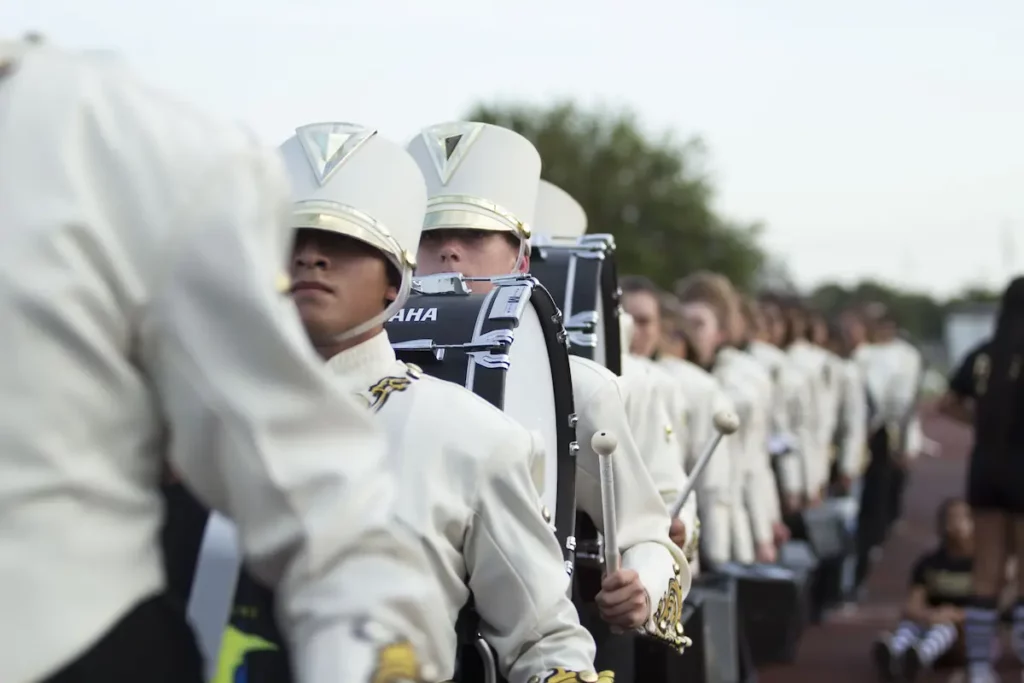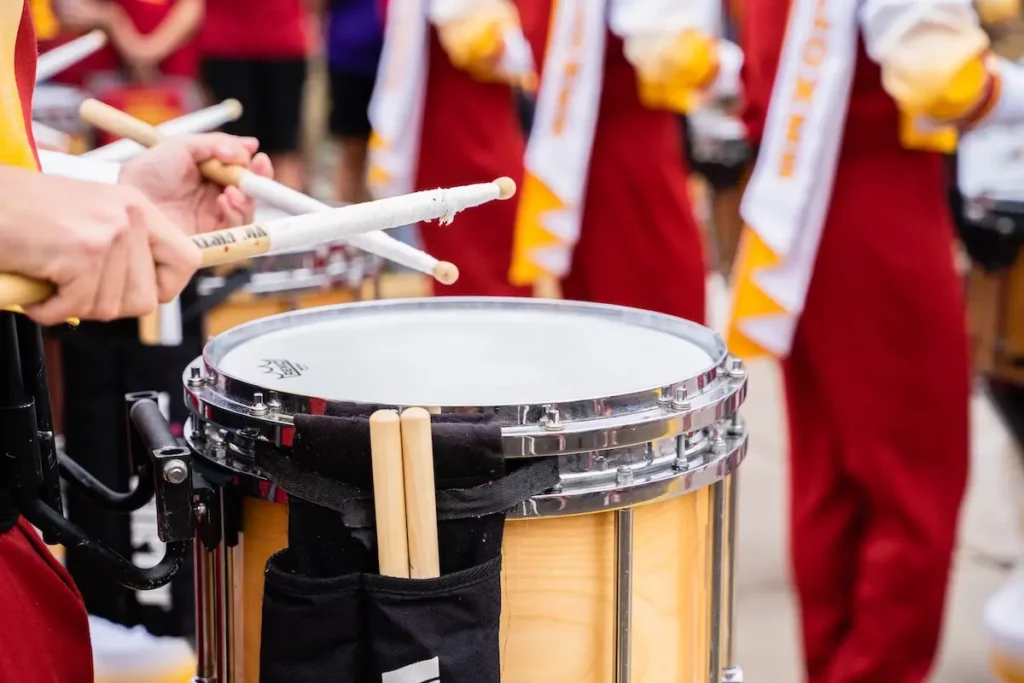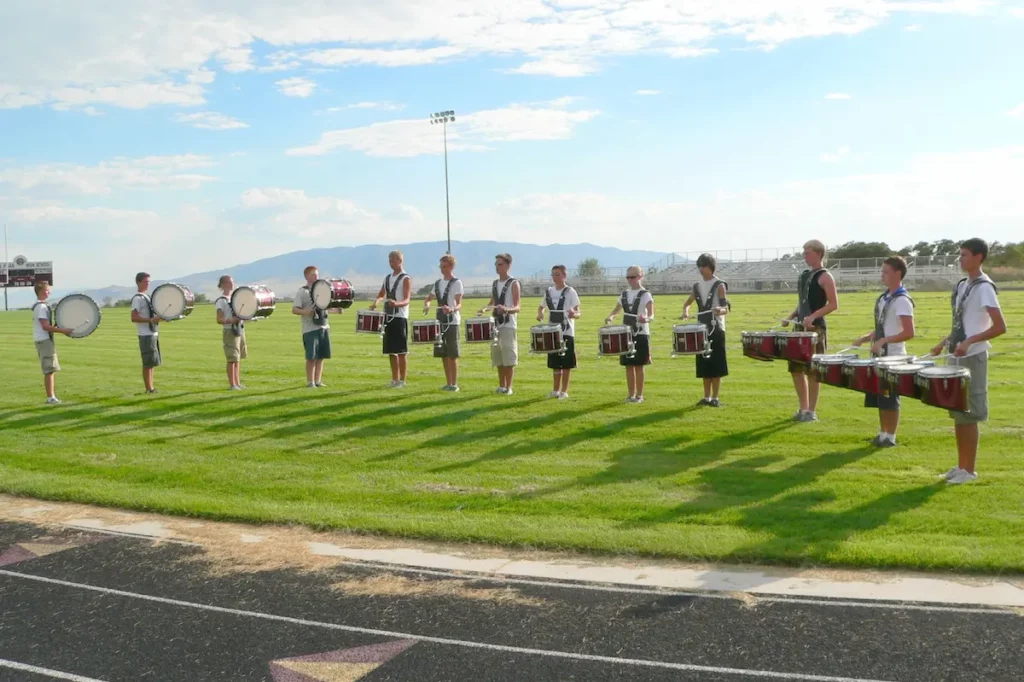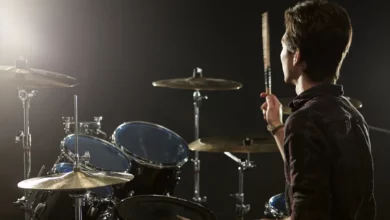
We may earn a commission from the affiliate links on this site. Learn more›
It’s drumline season, which means that kids across the country have begun to enter the familiar, panic-stricken state that often accompanies drumline auditions. But don’t worry, because drumline auditions don’t have to be as scary as they seem. Here’s a quick guide to help you survive auditions!
Components of a Drumline
The concept of a drumline is pretty simple – a group of people who drum together – but it’s important to have some background information that goes a little deeper than that before your first audition. A drumline is typically made up of cymbals (for some drumlines), basses, tenors/quads, and snares. If you’re new to drumline, it might be a little difficult to get some of the details straight in your head.
Cymbals
Some drumlines have a cymbal line, where people march and play cymbals. Cymbals often have the least complicated parts, and the cymbal line is often made up of people who are newer to drumline. However, in upper-level marching bands and drum corps, cymbals often have split parts, just like the basses. Cymbals typically get more difficult in higher-level performing groups.

Cymbals are a great instrument to try for if you’re new to drumline or if you don’t feel ready to play one of the drums. As mentioned above, cymbal parts tend to be the simplest and easiest to play. They do have splits sometimes, so cymbals can serve as a great introduction to get you ready to march bass in the future.
Cymbals are great for newbies because they teach marching, marking time, and they provide a general introduction to the drumline environment. They’re also the lightest component to carry around, if you haven’t yet developed your six pack abs and shoulders of steel.
Basses
Basses are the deep-sounding, round drums of varying sizes. Most drumlines have anywhere from four to six basses, with the average being five. Bass 1 is the highest pitched, and the biggest bass is the lowest pitched. Basses have split parts, meaning that each player plays a different rhythm. When played at the same time, these rhythms come together to form one cohesive musical part.

Bass is sometimes considered the easiest out of the three drum options, but that perception can often be flawed, especially when it comes to upper level performing groups. However, if you’re trying out for your high school drumline, bassline can be a great entry point for newbies, especially if your school doesn’t have a cymbal line.
Bass parts usually aren’t as technically hard as snare and tenor parts, but the timing can often be challenging, since the parts are split. Higher basses (one, two, and three) often have harder rhythms than the lower basses. In general, if you have great rhythmic timing, bass is probably for you!
Tenors/Quads
Tenors (or quads, the names are used interchangeably), are five or six connected drums that are each pitched differently. Tenor parts often have unique components such as crossovers (reaching one hand over the other), scrapes (moving quickly from one drum to the next), and rhythms that require coordination.

Tenor spots are often taken by more experienced members of the drumline, but that doesn’t mean that newbies shouldn’t try them out! If you’re a newbie and have an interest in playing tenors, it’s a great idea to learn the tenor music and bass/cymbals music, so that you have a backup option.
Tenors are often very technically complicated, due to the unique nature of playing the instrument. Tenors often play the same rhythms as snare but split over multiple different drums.
Snares
Snares are high-pitched, single drums. These drums can often be very loud, so you should definitely bring some sound-cancelling earbuds or other forms of hearing protection. Some drumlines have their snares play in traditional grip, which is a special way to hold the left drumstick that is specific to the snares. Other drumlines have their snares play in matched grip, which is just the “regular” way to hold drumsticks.

Like tenors, the snare line is often made up of more experienced members of a drumline. Just like with tenors, newbies should still feel motivated to try out if they have an interest, as long as they also have a backup option. Snare parts are often considered the most technically difficult of the instruments on a drumline, as they are usually “beefed up” versions (slightly more difficult versions) of the tenor part. Keep in mind that some snare lines play with traditional grip, so be sure to learn that before auditions if it’s needed for your drumline.
Tips for Auditioning for a Drumline
Come prepared – Whether you have experience on the drumline or not, you need to come to auditions extremely prepared. This means playing through the whole audition packet and audition pieces prior to the audition. A great strategy is to break the amount of time until auditions into sections, so you can set goals for which pages of the packet you want to have learnt by which dates. You should aim to have all of the music learned a good amount of time before the first audition, so you’ll have time to polish up the parts.
Practice the Right Way! – When it comes to practice, quality is more important than quantity. While you should practice regularly, what you do and how you practice the drums will be essential to your success. Here are a few tips:
- Set goals for each practice session.
- Write down progress, tempos, and areas you struggle with.
- If possible, try and practice with the other people auditioning on your instrument. This will help get you used to playing with those specific people, which will help you sound more cohesive and clean at the audition.
Remember, it’s also important to practice consistently. It’s better to do a thirty-minute session every day, than to practice for three hours the night before auditions.
Know the Line You’re Auditioning For
Before the first audition, try and gather some information about the drumline you’re auditioning for. How many snares, tenors, and basses are they going to have? Do the snares play match grip or traditional grip? Do they have a marching cymbal line?
Knowing the answers to these questions can help you better prepare for your audition. You should tie this tip to the first one, and make sure you’re practicing in a way that corresponds with any information you know about the drumline.
Understand What They Need
This point is incredibly important – if you know what the drumline is looking for, you will be able to tailor your behavior and playing accordingly. If you can exemplify the traits and abilities that they want on the drumline, your chances of making the drumline get a whole lot better. Some common characteristics and abilities drumlines look for include work ethic, playing ability, success playing in a group, and musicality.
Work Ethic
Work ethic is one of the most important traits to have when auditioning for drumline for one simple reason – being on a drumline requires hard work! From practicing for hours on end, to carrying heavy drums across the field, nothing about drumline is easy.
This means that the audition staff are probably looking for people with the best work ethic, to ensure that the drumline will be able to push through challenges. The best way to show your work ethic in an audition is to prepare before the audition. The people who show up with their music prepared are perceived to have better work ethic than someone who shows up and doesn’t know the music.
Also, don’t forget that if you are in the band, you’re constantly auditioning for the spot you want next year. Show your captain some initiative by taking on tasks like packing/unpacking at events, mentoring others in the band, etc. Leaving a strong impression on your captain throughout the current year with consistency and hard work is the best way to prove that you’re ready for the role you’re hoping for next year.

Playing Ability and Adaptation
Playing ability simply refers to a person’s ability to drum. This trait ties into rhythmic accuracy and musicality. Like the previous trait, the best way to show your playing ability is to show up prepared! If you can play all the music well, the staff will likely assume you can play at a high level.
This next trait, the ability to play with a group, is sometimes overlooked when preparing for an audition. However, playing with a group is arguably the most important part of a drumline audition. A drumline has to sound good together.
It doesn’t matter how good each individual player is, if they don’t know how to sound good as a group. A word you might hear thrown around the drumline community is the idea of a “clean” drumline. A clean drumline is a drumline that plays with clarity. This means that even if there are six or seven snares playing, they should be so in-sync that it sounds like only one person is playing.
A great way to practice playing with clarity is to practice with a friend. This can help you build the skill of matching someone else’s playing style, which will help you sound better when playing with the rest of the people at the audition.
Musicality
The final trait for success is musicality, which is mostly comprised of phrasing and dynamics. On a drumline, dynamics are achieved through various stick heights. Stick heights are how high your sticks
come up before every note. These should be uniform throughout the drumline, in order to achieve accurate dynamics and contribute to the visual effect of the drumline. At the audition, make sure to pay attention to the dynamics in the music.

Looking In
Another really important skill is “looking in”, which is essentially looking towards the center snare or center tenor to set the stick heights for the section. The center snare or tenor is usually the section leader, or the one in charge of the section. This means that they will set the standard for stick heights, sound quality, and even when to stay set. You should try to match your stick heights and playing style to them.
Wrapping Up
All of this can definitely be a lot to think about at the audition but remember – drumline is supposed to be fun! Take a deep breath and make sure you don’t lose yourself in the stress of audition season. You should drum because you love it.
Even if you don’t end up with the drumline spot you wanted, you can still enjoy your experience, whether it be on a different drumline instrument, in the front ensemble, or in something else altogether. So as you prepare for drumline auditions, make sure to exemplify your best self, and then accept whatever result comes with that.



